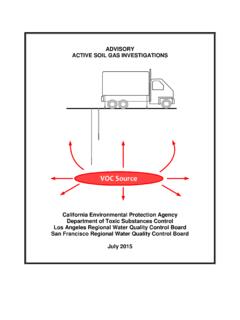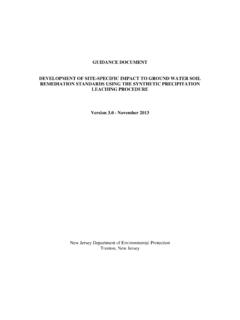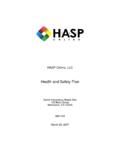Transcription of Supplemental Guidance: Screening and Evaluating Vapor ...
1 Supplemental Guidance: Screening and Evaluating Vapor Intrusion Draft for Public Comments California Department of Toxic Substances ControlCalifornia Water Resources Control BoardsFebruary 2020 PUBLIC DRAFT Supplemental Guidance: Screening and Evaluating Vapor Intrusion Department of Toxic Substances Control California Water Resources Control Boards February 2020 Disclaimer: This document is guidance and is not intended as regulation or water quality control plan or policy. This Supplemental Guidance describes a consistent approach recommended for Evaluating Vapor intrusion in California. This Supplemental Guidance is not binding on California Environmental Protection Agencies or staff, or on members of the public. This Supplemental Guidance is not intended to exclude alternative methodologies nor is it intended to provide prescriptive or inflexible requirements.
2 This Supplemental Guidance does not supersede or implement laws or regulations and does not have the force or effect of law. Petroleum releases from underground storage tanks (USTs) must be evaluated for Vapor intrusion using the State Water Resources Control Board s Resolution 2012-0062, Low-Threat Underground Storage Tank (UST) Case Closure Policy (LTCP) adopted November 6, 2012 (State Water Board, 2012b). Public Draft - Supplemental Guidance: Screening and Evaluating Vapor Intrusion February 2020 i Acknowledgement This Supplemental Guidance was prepared through the efforts of the following members of the California Environmental Protection Agency (CalEPA) Vapor Intrusion Workgroup: Karen Baker (co-chair), Dan Gallagher, Barbara Renzi, Claudio Sorrentino, Maya Akula, Patrice Bowen, and Stacey Lear of the Department of Toxic Substances Control; Nicole Fry, Cheryl Prowell (co-chair), and Ross Steenson of the San Francisco Bay Regional Water Quality Control Board; Jessica Law of the Santa Ana Regional Water Quality Control Board; Karen Kramer, Steve McMasters, Tina Ures, Abrahm Waggoner, and Marina Perez, of the State Water Resources Control Board.
3 And Carmen Milanes and Amanda Palumbo with Office of Environmental Health Hazard Assessment. Public Draft - Supplemental Guidance: Screening and Evaluating Vapor Intrusion February 2020 ii Contents Executive Summary .. v Flowchart .. ix Introduction .. 1 A Scope and Applicability .. 1 B Relation to Existing Guidance or Policy .. 2 C Conceptual Model for Vapor Intrusion .. 3 D Vapor Attenuation Factors .. 4 D1 Recommended Attenuation Factors for Screening .. 5 D2 Alternatives for Screening .. 6 E Evaluation of Lines of Evidence .. 6 F California Vapor Intrusion Database .. 7 Step 1: Prioritize Buildings and Select sampling Approach for VI Evaluation .. 9 Step 1A Expedite VI Evaluations: Acute and Short-Term Hazard .. 9 Step 1B Prioritize Buildings for VI Evaluation .. 9 Proximity to Contamination.
4 9 Contaminated Vapor Conduits .. 10 Occupancy and Receptors .. 10 Step 1C Select sampling Approach: Soil Gas Screening or Indoor Air .. 10 Step 2: Evaluate Vapor Intrusion Risk Using Soil Gas Data .. 11 Step 2A Evaluate Spatial Distribution of Soil Gas Contamination .. 12 Soil Gas: sampling Method .. 12 sampling to Characterize the Overall Soil Gas Plume .. 12 sampling to Evaluate Risk to Building Occupants .. 13 Step 2B Estimate Human Health Risk from Vapor Intrusion .. 15 Estimate Potential Indoor Air Concentration .. 15 Estimate Cancer Risk and Noncancer Hazard Quotient .. 16 Estimate Cumulative Risk and Hazard .. 17 Evaluate Risk .. 17 Step 2C Evaluate Temporal Variability .. 17 sampling Frequency .. 17 Re-Evaluate Risk .. 17 Step 2D Decide on Next Step.
5 17 Public Draft - Supplemental Guidance: Screening and Evaluating Vapor Intrusion February 2020 iii Step 3: Indoor Air Investigation Identify Buildings Where Vapor Intrusion is Occurring Using Concurrent Indoor Air, Subslab Soil Gas, Soil Gas, and Outdoor Air sampling Data .. 18 Step 3A Conduct In-Depth Building Survey .. 18 Identify Building Type, Characteristics, and Condition .. 18 Locate and Remove Potential Indoor Sources of VFCs .. 19 Conduct Field Screening for VFCs Using a Sufficiently Sensitive Field Instrument .. 19 Observe Surrounding Area for Potential Outdoor Sources .. 19 Step 3B Evaluate Spatial Distribution .. 19 Indoor Air: sampling Method .. 20 Subslab Soil Gas: sampling Method .. 21 Outdoor Air: sampling Method .. 21 Indoor Air and Subslab Soil Gas: Location and Number of Samples.
6 21 Outdoor Air: Location and Number of Samples .. 22 Complementary Lines of Evidence .. 22 Step 3C Assess Risk from Contaminated Indoor Air and Subslab Soil Gas .. 23 Identify and Address Confounding Factors .. 24 Estimate Risk from Indoor Air Data .. 24 Estimate Potential Future Risk from Subsurface Data .. 24 Assess Cumulative Risk .. 24 Characterize Risk .. 25 Step 3D Evaluate Temporal Variability .. 25 sampling Frequency .. 26 Re-Evaluate Risk .. 27 Step 3E Decide on Next Step .. 27 Step 4: Current and Future Risk Evaluation and Management Decisions .. 27 Step 4A Need for Risk Management .. 27 Step 4B Manage Current Vapor Intrusion Risk .. 28 Step 4C Manage Future Vapor Intrusion Risk .. 29 Application to Other Building Types .. 30 BUILDING I Large Buildings and Multistory Buildings.
7 30 Sample Locations in Step 3 .. 30 Calculate VI Risk Using Indoor Air in Step 3 .. 31 Public Draft - Supplemental Guidance: Screening and Evaluating Vapor Intrusion February 2020 iv Sample Frequency in Step 3 .. 31 BUILDING II Crawl Space Buildings .. 31 Crawl Space Air: sampling Methods .. 32 Crawl Space Air: Sample Locations in Step 2 and Step 3 .. 32 Step 2 Specific Criteria for Crawl Space Air sampling .. 32 Step 3 Specific Criteria for Crawl Space Air sampling .. 33 BUILDING III Building with Above-Grade or Below-Grade Parking Structures 33 Parking Garage Air: sampling Methods .. 34 Parking Garage Sample Locations in Step 2 and Step 3 .. 34 References .. 35 Glossary of Acronyms & Abbreviations .. 42 Attachments: Attachment 1 Petroleum Specific Considerations Attachment 2 Sewers and Other Vapor Conduits as Preferential Pathways for Vapor Intrusion Attachment 3 Groundwater as Line of Evidence to Evaluate VI Risk Attachment 4 Guidance on Uploading Vapor Intrusion Information Into GeoTracker Attachment 5 Building Survey and Indoor Air Source Screen Forms Public Draft - Supplemental Guidance.
8 Screening and Evaluating Vapor Intrusion February 2020 v Executive Summary Introduction The Department of Toxic Substances Control (DTSC), the San Francisco Bay Regional Water Quality Control Board (SF Bay Regional Water Board), and the State Water Resources Control Board (State Water Board) developed this Supplemental Guidance to promote state-wide standard practice and consistency for Screening buildings for Vapor intrusion and to establish appropriate sampling to protect building occupants from vapors off-gassing from contaminated sources. Addressing Vapor intrusion is critical to protect people from exposures that may pose a risk of adverse health effects. A workgroup, consisting of members from the agencies listed above under the guidance of California Environmental Protection Agency (CalEPA), prepared this document as a supplement to existing information, not a standalone document.
9 The urgency to protect building occupants from the short-t erm exposure effects of trichloroethylene (TCE) at relatively low concentrations was part of the impetus that led to the formation of the CalEPA Workgroup. The Supplemental Guidance recommends a consistent approach to be used by practitioners and regulators when Screening buildings for subsurface Vapor risk to building occupants. It does not provide guidance on the sampling required for all media (soil, Vapor , and groundwater) to determine the nature and extent of contamination in development of a conceptual site model. This Supplemental G uidance describes a framework for deciding when cleanup and/or mitigation is needed. This Supplemental Guidance is published as a draft document available for public comment. The CalEPA workgroup will review and consider the public comments for incorporation into a future, finalized version of this Supplemental G uidance.
10 Additionally, the CalEPA workgroup will evaluate the Vapor and building data submitted through the State Water Board s GeoTracker Electronic Submittal of Information (ESI) process and other available data to assess and develop California-specific Vapor intrusion evaluation criteria. At the completion of the analysis, the California-specific information will be shared with the public. The following websites provide general information on Vapor intrusion and how to provide comments on this Draft Supplemental Guidance: State Water Board: DTSC: Background Vapor intrusion (VI) is the migration of chemical vapors from the subsurface into buildings and is a frequent problem at contaminated sites. If uncontrolled, chemical vapors can migrate into buildings and pose a risk to human health. Vapor migration in the subsurface, through building foundations, and within buildings is complex and Public Draft - Supplemental Guidance: Screening and Evaluating Vapor Intrusion February 2020 vi influenced by many natural and human-caused factors.








